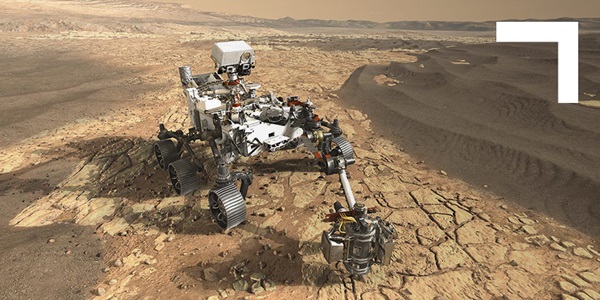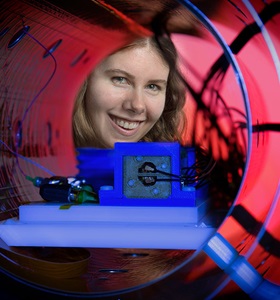Designers to the Stars

By Brooks McKinney, APR
Before launching onto the celestial stage, a spacecraft must first be dressed in "clothes" to protect it from extreme space temperatures. What may look like a glittery, gold gown covering every appendage and critical structure is actually multi-layer insulation (MLI): multiple, tissue paper-like layers of metalized films such as Kapton or Mylar designed to maintain the vehicle's subsystems within a specified temperature range.
This includes complex spacecraft such as NASA’s James Webb Space Telescope, to small, experimental satellite for other government customers.
Of course, behind every great outfit is a great designer. Enter Northrop Grumman's renowned MLI team. This tight-knit group of precision "tailors" designs, fabricates and installs MLI on a majority of Northrop Grumman-produced spacecraft.
"The MLI team is truly a 'womb-to-tomb' organization," explains Ralph Stephenson, one of the team's two functional managers. "Our work begins in the earliest days of spacecraft conception and doesn't wrap up until the vehicle is ready to be launched. Very few disciplines in this industry are as engaged in spacecraft integration or mission success as we are."

Covering the Waterfront
Based in Northrop Grumman's Space Park facility in Redondo Beach, California, the MLI team comprises 25 to 30 design engineers and technicians. Their tenure ranges from more than 40 years to just over 18 months, with an average of about 20 years.
“We get to work on a satellite from the very beginning, and we're the last ones to touch it before it launches,” says Tonya Villa, a senior design engineer and the team's longest-tenured member. “After all these years, it's still very exciting.”
The team performs its spacecraft work primarily in Space Park but also at company facilities in Dulles, Virginia; Baltimore, Maryland; and Oxnard, California.
"Once you pick up a part and install it, you have a responsibility to make sure that it's on right, otherwise it could damage something or prevent some key part of the satellite from operating properly."
— Laura Sisneros, MLI Team Technician

Teaching the Art
At its essence, the MLI process involves creating an electronic 3D model of each major spacecraft structure, generating a 2D paper template from that model, much like a dress pattern, using the template to cut MLI material and fabricate the blanket, and then attaching the blanket to the spacecraft.
Most MLI team members began as technicians and learned their skills on the job. Every one of them, however, recognizes the importance of training the next generation who will carry on the MLI craft.
“We generally pair up a new technician with a senior technician who will show them how to read a template, cut the MLI material and fabricate a blanket,” says Villa. “You may start off making something simple, but pretty soon you're making parts that are very detailed.”
Ensuring Success
Ultimately, installing MLI on a spacecraft with speed and precision is the team's raison d'être. MLI covers and provides passive thermal control for the entire vehicle while allowing its appendages to deploy and move freely. And every installation matters.
"Once you pick up a part and install it, you have a responsibility to make sure that it's on right, otherwise it could damage something or prevent some key part of the satellite from operating properly," says Laura Sisneros, a technician and 23-year veteran of the team. "Initially, it's a little scary because of the responsibility you're carrying for your department, the program and even the country."
"Our work begins in the earliest days of spacecraft conception and doesn't wrap up until the vehicle is ready to be launched. Very few disciplines in this industry are as engaged in spacecraft integration or mission success as we are."
— Ralph Stephenson, MLI Team Functional Manager

Crafting Excellence
Indeed, installing MLI can be both challenging and a bit nerve-wracking.
“About five percent of the time, we can just walk up to a satellite and install an MLI blanket,” says Steve Taylor, the team's MLI subject matter expert. “Most of the time, however, the crew is on ladders or lifts, or lying on their backs, or crawling around under the satellite, almost like working on a car.” All of which provide essential training opportunities.
“We try to pair up newer team members with a different senior person for each MLI task,” he continues. “Installing MLI is truly a craft, and every veteran of our team has tips and tricks they can show to our newer team members.”
This is not to say that new MLI employees don't bring fresh ideas to the team.
“When someone new joins the team and suggests a potentially faster or smarter way to do something, we're open to that,” says Stephenson. “We will never ‘not try' something new.”
Saving Schedule
And when the team isn't busy trimming, pleating and tucking MLI into all the right places, it's likely helping resolve last-minute surprises in spacecraft integration.
"Sometimes mechanical designers don't recognize potential problems with their hardware until it gets put together," explains Villa. "So we assist them by designing deployment aids that prevent hardware from snagging on our MLI. Allowing our team to make these changes eliminates costly and time-consuming hardware redesign efforts, and keeps the program on schedule."
Making Everything Right
For all the discipline and rigor involved in MLI projects, however, success boils down to appearance.
"If we've done our best work fabricating and installing the MLI blankets, everything just looks right," reflects Stephenson. "You only notice things when they're a bit off — wrinkles going in the wrong direction, perhaps a blanket pulling slightly at one corner. When everything is on right, when everything is straight, it looks like it belongs there. And that's when we know we're done."
More innovation stories
Read all stories about advanced technology and innovation >>


